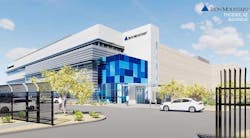Phoenix Data Center Growth Accelerated by Surge in Leasing
We continue our series of stories on the leading geographic markets for data center space. Data Center Frontier is partnering with DatacenterHawk to provide in-depth market reports on each city we profile. This time, we explore Phoenix data center growth, accelerated by a variety of favorable market factors. The following is the first entry in a four-part series that gives readers a market overview and analysis of the Phoenix colocation market.
Download the full report.
Phoenix has become one of the most dynamic data center growth markets in the U.S., with a surge in leasing in the past two years, including major deals featuring hyperscale cloud companies. Users have long sought space in Phoenix as an alternative to California locations with higher cost and disaster risk. It’s now clear that Phoenix is becoming a data center destination in its own right, attracting a larger concentration of both customers and service providers in the process.
The Phoenix market is home to 1.61 million square feet (SF) of commissioned data center space, representing 211 megawatts (MW) of commissioned power, according to market research from datacenterHawk. That makes Phoenix the sixth largest market for data center capacity in the U.S., trailing Northern Virginia, Silicon Valley, Dallas, Chicago and New Jersey.
Growth trends suggest that Phoenix will join the Top 5 markets in 2018, with total capacity that exceeds that of New Jersey. There was a solid 24 megawatts (MWs) of capacity absorbed in 2017, and 2018 is shaping up as another strong year, with 9.8 MWs of absorption in 2Q 2018 alone.
Enormous Building Boom on the Horizon
The most remarkable aspect of the Phoenix market is the industry optimism about future demand. Phoenix data center growth is not expected to lull anytime soon. In fact, data center developers have 707 MWs of capacity on the planning board, more than any market except Northern Virginia. The surging demand in Phoenix has also attracted new players, and prompted expansions by existing providers. Iron Mountain, EdgeCore, CyrusOne, QTS Data Centers, Digital Realty, EdgeConneX and Aligned Data Centers have all announced new campuses or expansions of existing properties.
At present, data center supply and demand appear to be well matched, as reflected in the vacancy rate of 9.4 percent in the region. This will be a number to watch as new capacity is deployed. A key factor will be whether service providers are able to successfully pre-lease space, or seek to build new projects on speculation in order to have inventory available for large deals.
As Lee McPheters, research professor of economics at Arizona State University noted in his 2015 economic outlook for Phoenix, the market’s economic challenges are related to the boom-and-bust cycle of the region’s housing market almost a decade ago. “The construction industry in Arizona is down about 100,000 jobs since its peak (in 2007)” said McPheters. “So if we had to point a finger, the construction industry alone has accounted for a high proportion of jobs not yet regained.”
However, the U.S. Bureau of Labor Statistics numbers showed a turnaround in 2015, as construction employment in Arizona steadily increased. In 2017, construction jobs grew by 8.8 percent, compared to a 2.7-percent boost in overall private sector employment.
A recent survey by IHS Markit found that small business wage growth in Phoenix grew 5.14% in the 12-month period ending in March 2018, the fastest growth rate in the U.S. Employment gains have also been seen in the financial, professional services, and education sectors for Phoenix, helping with data center adoption in the market.
Low Disaster Risk
The Phoenix market benefits from its reasonably low power cost, especially when compared to the highly-occupied Northern California and Los Angeles data center markets, where there is a significant price difference. Power cost is a critical decision point for both data center providers and users, and the difference of a few cents per kilowatt can mean millions of dollars saved for data center transactions.
In addition, Phoenix is viewed as a disaster recovery market specifically tied to its low threat for natural disasters. For example, according to the United States Geological Survey, the city ranks on the lowest scale of earthquake threat. In addition, the threat for tornadoes and floods is at a minimum. Compared to nearby primary data center markets, Phoenix is a market companies feel safe investing in.
Phoenix’s desert environment also provides opportunities for free cooling at night, directly impacting a data center’s power usage effectiveness (PUE) and operational cost. Arizona’s politicians have increased the appeal of the market to data center users by offering 10-year tax breaks on both data center equipment and labor services.
This Data Center Frontier series focused on Phoenix data center growth will also cover the following topics for the area in the coming weeks:
- Trends in Demand
- Trends in Supply
- Business Environment
Download the full Data Center Frontier Phoenix Data Center special report, courtesy of Iron Mountain.
And for further coverage, check out Data Center Frontier’s page dedicated to the Phoenix Data Center Market, that will provide the latest stats and info on this quickly growing area that is becoming a leading market in the colocation industry.






